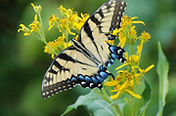Park Activities
Calendar of Events
Volunteer Programs
Sky Meadows Park
Location
Geography
Habitats
Trails
Visiting Park
Crooked Run Valley
Special Projects

common vetch (Vicia sativa)
COMMON NAMES:
common vetch
garden vetch
spring vetch
tare
SCIENTIFIC SYNONYMS:
Vicia angustifolia L.
Vicia angustifolia L. var. segetalis (Thuill.) W.D.J. Koch
Vicia sativa var. angustifolia (L.) Ser.
Vicia sativa var. nigra L.
Vicia sativa var. segetalis (Thuill.) Ser.
CONFIRMATION STATUS: Pending confirmation.
TAXONOMY: The currently accepted scientific name for common vetch is Vicia sativa L. Two subspecies are recognized as occurring in Virginia - subspecies nigra (L.) Ehrh. and subspecies sativa. These infraspecific taxa have generally not been distinguished among herbarium specimens and cannot be differentiated at the present time.
It should be noted, however, that subspecies nigra is common throughout; the status of ssubspecies sativa has not been determined.
NATIVE STATUS: Introduced, United States and Canada.
GENERAL BOTANICAL CHARACTERISTICS:
Habit: Common vetch has slender stems which are viney, branched and ascending (although it is sometimes is decumbent) or climbing and hairy to varying degrees, sometimes minutely so. It grows up to 2 metres tall; its stem is hollow and four-angled.
Leaves: Leaves are compound in 4 to 8 pairs with a branched tendril at the tip to clasp surrounding vegetation for support. Leaflets are oval elliptic to nearly linear, ¾ to 1¼ inches long, 1/6 to 1/3 inch wide, sparsely hairy on the underside, often flattened or indented at the tip, with a small spine-like projection. A pair of leafy appendages (stipules) at the leaf joint are small and somewhat variable, with 2 or more sharp teeth, often with a small dark gland spot underneath.
Flowers: 1 or 2 nearly stalkless pea-shaped flowers in the upper leaf axils. Flowers are ¾ to 1¼ inch long, pink to purple, the upper petal (standard) is broad, flaring up and notched in the center, the two lateral wings below it are oval shaped and often darker colored than the standard; they flank and obscure the lower keel underneath. The calyx holding the flower is usually minutely hairy with prong-like teeth about as long as the tube
Fruits/Seeds: Fruit is a flat pea pod up to 2 inches long, producing 4 to 12 round beans. Pods ripen to light brown. The seeds are round and somewhat laterally flattened and are black to brownish in colour.
Roots: Common vetch has a Slender taproot system with numerous lateral branches.
REGENERATION PROCESS: Common vetch propogates itself by reseeding.
HABITAT TYPES: Habitats consist of cropland (mainly wheat fields), fallow fields, weedy meadows, roadsides, areas along railroads, shores of rivers or lakes, and miscellaneous waste areas. Common vetch has been deliberately planted as a source of forage for farm animals. Habitats with a history of disturbance are strongly preferred.
SITE CHARACTERISTICS: Common vetch adapts to full or partial sun, moist to dry-mesic conditions, and a variety of soil types, including those that contain loam and clay-loam although it does not usually take root in soils that are acidic or poorly drained. The root system can nodulate and add nitrogen to the soil.
SEASONAL DEVELOPMENT: The blooming period occurs from late spring to mid-summer for about 2 months.
GENERAL DISTRIBUTION: Common vetch is found throughout the United States (except Utah) and in all Canadian provinces (excluding Saskatchewan, Alberta, the Northwest Territory, and Nunavut).
SKY MEADOWS DISTRIBUTION: Pending confirmation.
IMPORTANCE AND USES: The flowers are cross-pollinated by bumblebees and other long-tongued bees. Various insects feed destructively on the foliage, flowers, or developing seedpods of Vicia spp. (Vetches). These species include the caterpillars of such butterflies as Colias eurytheme (orange sulfur), Colias philodice (clouded sulfur), Everes comyntas (eastern tailed blue), Glaucopsyche lygdamus couperi (silvery blue), Leptotes marina (marine blue), and Strymon melinus (gray hairstreak). It also includes caterpillars of the skipper, Erynnis funeralis (funereal duskywing), and the moth, Caenurgina chloropha (vetch looper). Vetches are food plants of Acyrthosiphon pisum (pea aphid), several leafhoppers (Empoasca spp.), and the thrips, Sericothrips cingulatus. The foliage of common vetch is edible to mammalian herbivores: It is readily eaten by cattle, horses, sheep, deer, rabbits, and groundhogs. Even though the seeds are potentially toxic, they are sometimes eaten by such upland gamebirds as the ruffed grouse, wild turkey, greater prairie chicken, and bobwhite; some of these birds also consume limited amounts of the foliage.
Ants seem to have a particular fondness for this plant, as it is common to find them nectaring at the gland on the stipule.
Common vetch is widely cultivated for its high quality forage (fresh, hay and silage) and grain for livestock. It is also a valuable cover crop and is used as green manure.

